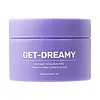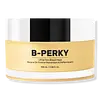What's inside
What's inside
 Key Ingredients
Key Ingredients

 Benefits
Benefits

 Concerns
Concerns

 Ingredients Side-by-side
Ingredients Side-by-side

Water
Skin ConditioningEthylhexyl Palmitate
EmollientPalmitic Acid
EmollientStearic Acid
CleansingPropylene Glycol
HumectantGlycerin
HumectantDimethicone
EmollientButyrospermum Parkii Butter
Skin ConditioningCetearyl Alcohol
EmollientCocos Nucifera Oil
MaskingMelatonin
AntioxidantChamomilla Recutita Flower Extract
MaskingAcrylates/C10-30 Alkyl Acrylate Crosspolymer
Emulsion StabilisingValeriana Officinalis Root Extract
Skin ConditioningSilybum Marianum Extract
Skin ConditioningLactobacillus Ferment
Skin ConditioningSarcothalia Crispata
CleansingPropanediol
SolventCarbomer
Emulsion StabilisingSodium Hydroxide
BufferingSodium Phytate
Magnesium Ascorbyl Phosphate
AntioxidantGluconolactone
Skin ConditioningCyathea Medullaris Leaf Extract
Skin ConditioningArctostaphylos Uva-Ursi Leaf Extract
Skin ConditioningPassiflora Edulis Seed Oil
EmollientMyristic Acid
CleansingC13-14 Isoparaffin
EmollientLaureth-7
EmulsifyingTocopherol
AntioxidantEthylhexylglycerin
Skin ConditioningPolyacrylamide
Phospholipids
Skin ConditioningPhenoxyethanol
PreservativeSodium Benzoate
MaskingPotassium Sorbate
PreservativeCalcium Gluconate
HumectantParfum
MaskingCitronellol
PerfumingCoumarin
PerfumingEugenol
PerfumingGeraniol
PerfumingLimonene
PerfumingLinalool
PerfumingCI 42090
Cosmetic ColorantCI 17200
Cosmetic ColorantWater, Ethylhexyl Palmitate, Palmitic Acid, Stearic Acid, Propylene Glycol, Glycerin, Dimethicone, Butyrospermum Parkii Butter, Cetearyl Alcohol, Cocos Nucifera Oil, Melatonin, Chamomilla Recutita Flower Extract, Acrylates/C10-30 Alkyl Acrylate Crosspolymer, Valeriana Officinalis Root Extract, Silybum Marianum Extract, Lactobacillus Ferment, Sarcothalia Crispata, Propanediol, Carbomer, Sodium Hydroxide, Sodium Phytate, Magnesium Ascorbyl Phosphate, Gluconolactone, Cyathea Medullaris Leaf Extract, Arctostaphylos Uva-Ursi Leaf Extract, Passiflora Edulis Seed Oil, Myristic Acid, C13-14 Isoparaffin, Laureth-7, Tocopherol, Ethylhexylglycerin, Polyacrylamide, Phospholipids, Phenoxyethanol, Sodium Benzoate, Potassium Sorbate, Calcium Gluconate, Parfum, Citronellol, Coumarin, Eugenol, Geraniol, Limonene, Linalool, CI 42090, CI 17200
Water
Skin ConditioningC12-15 Alkyl Benzoate
AntimicrobialGlycerin
HumectantCetyl Alcohol
EmollientKaolin
AbrasiveSteareth-2
EmulsifyingSteareth-21
CleansingDimethicone
EmollientSimmondsia Chinensis Seed Oil
EmollientSodium Hyaluronate
HumectantPalmitoyl Isoleucine
Skin ProtectingKigelia Africana Fruit Extract
Skin ConditioningAllantoin
Skin ConditioningZinc Oxide
Cosmetic ColorantIlex Paraguariensis Leaf Extract
PerfumingTocopheryl Acetate
AntioxidantButyrospermum Parkii Butter
Skin ConditioningDisodium EDTA
Phenoxyethanol
PreservativePolyacrylamide
C13-14 Isoparaffin
EmollientEthylhexylglycerin
Skin ConditioningChlorphenesin
AntimicrobialLaureth-7
EmulsifyingPalmitic Acid
EmollientParfum
MaskingCI 19140
Cosmetic ColorantCI 15985
Cosmetic ColorantWater, C12-15 Alkyl Benzoate, Glycerin, Cetyl Alcohol, Kaolin, Steareth-2, Steareth-21, Dimethicone, Simmondsia Chinensis Seed Oil, Sodium Hyaluronate, Palmitoyl Isoleucine, Kigelia Africana Fruit Extract, Allantoin, Zinc Oxide, Ilex Paraguariensis Leaf Extract, Tocopheryl Acetate, Butyrospermum Parkii Butter, Disodium EDTA, Phenoxyethanol, Polyacrylamide, C13-14 Isoparaffin, Ethylhexylglycerin, Chlorphenesin, Laureth-7, Palmitic Acid, Parfum, CI 19140, CI 15985
Ingredients Explained
These ingredients are found in both products.
Ingredients higher up in an ingredient list are typically present in a larger amount.
This ingredient is also known as shea butter. It is an effective skin hydrator and emollient.
Emollients help soothe and soften your skin. It does this by creating a protective film on your skin. This barrier helps trap moisture and keeps your skin hydrated. Emollients may be effective at treating dry or itchy skin.
Shea butter is rich in antioxidants. Antioxidants help fight free-radicals, or molecules that may harm the body. It is also full of fatty acids including stearic acid and linoleic acid. These acids help replenish the skin and keep skin moisturized.
While Shea Butter has an SPF rating of about 3-4, it is not a sunscreen replacement.
Shea butter may not be fungal acne safe. We recommend speaking with a professional if you have any concerns.
Learn more about Butyrospermum Parkii ButterThis ingredient is also known as "C13-14 Isoalkane".
C13-14 Isoparaffin is created from petroleum-based mineral oils. It is an emollient and helps thicken a product.
As an emollient, it helps keep the skin soft and smooth by creating a barrier on top. This barrier traps moisture in, keeping the skin hydrated.
C13-14 Isoparaffin may not be fungal-acne safe.
Learn more about C13-14 IsoparaffinDimethicone is a type of synthetic silicone created from natural materials such as quartz.
What it does:
Dimethicone comes in different viscosities:
Depending on the viscosity, dimethicone has different properties.
Ingredients lists don't always show which type is used, so we recommend reaching out to the brand if you have questions about the viscosity.
This ingredient is unlikely to cause irritation because it does not get absorbed into skin. However, people with silicone allergies should be careful about using this ingredient.
Note: Dimethicone may contribute to pilling. This is because it is not oil or water soluble, so pilling may occur when layered with products. When mixed with heavy oils in a formula, the outcome is also quite greasy.
Learn more about DimethiconeEthylhexylglycerin (we can't pronounce this either) is commonly used as a preservative and skin softener. It is derived from glyceryl.
You might see Ethylhexylglycerin often paired with other preservatives such as phenoxyethanol. Ethylhexylglycerin has been found to increase the effectiveness of these other preservatives.
Glycerin is already naturally found in your skin. It helps moisturize and protect your skin.
A study from 2016 found glycerin to be more effective as a humectant than AHAs and hyaluronic acid.
As a humectant, it helps the skin stay hydrated by pulling moisture to your skin. The low molecular weight of glycerin allows it to pull moisture into the deeper layers of your skin.
Hydrated skin improves your skin barrier; Your skin barrier helps protect against irritants and bacteria.
Glycerin has also been found to have antimicrobial and antiviral properties. Due to these properties, glycerin is often used in wound and burn treatments.
In cosmetics, glycerin is usually derived from plants such as soybean or palm. However, it can also be sourced from animals, such as tallow or animal fat.
This ingredient is organic, colorless, odorless, and non-toxic.
Glycerin is the name for this ingredient in American English. British English uses Glycerol/Glycerine.
Learn more about GlycerinLaureth-7 is created by the ethoxylation of lauryl alcohol using ethylene oxide. Lauryl alcohol is a fatty alcohol with hydrating properties.
This ingredient is an emulsifier and cleansing ingredient. As an emulsifier, it is used to prevent ingredients from separating. It also helps cleanse the skin by gathering dirt, oil, and pollutants to be rinsed away.
Palmitic Acid is a fatty acid naturally found in our skin and in many plant and animal sources. In cosmetics, it is usually derived from palm oil. It serves many purposes in skincare, acting as a cleanser, emollient, and emulsifier.
As an emollient, palmitic acid helps soften and smooth the skin by preventing water loss. In cleansers, it helps remove oil and dirt while creating foam.
Its emulsifying properties help stabilize products by keeping water and oil-based ingredients from separating.
This may not be suitable for fungal acne-prone skin, as fatty acids like this can sometimes trigger breakouts in sensitive individuals.
Learn more about Palmitic AcidParfum is a catch-all term for an ingredient or more that is used to give a scent to products.
Also called "fragrance", this ingredient can be a blend of hundreds of chemicals or plant oils. This means every product with "fragrance" or "parfum" in the ingredients list is a different mixture.
For instance, Habanolide is a proprietary trade name for a specific aroma chemical. When used as a fragrance ingredient in cosmetics, most aroma chemicals fall under the broad labeling category of “FRAGRANCE” or “PARFUM” according to EU and US regulations.
The term 'parfum' or 'fragrance' is not regulated in many countries. In many cases, it is up to the brand to define this term.
For instance, many brands choose to label themselves as "fragrance-free" because they are not using synthetic fragrances. However, their products may still contain ingredients such as essential oils that are considered a fragrance by INCI standards.
One example is Calendula flower extract. Calendula is an essential oil that still imparts a scent or 'fragrance'.
Depending on the blend, the ingredients in the mixture can cause allergies and sensitivities on the skin. Some ingredients that are known EU allergens include linalool and citronellol.
Parfum can also be used to mask or cover an unpleasant scent.
The bottom line is: not all fragrances/parfum/ingredients are created equally. If you are worried about fragrances, we recommend taking a closer look at an ingredient. And of course, we always recommend speaking with a professional.
Learn more about ParfumPhenoxyethanol is a preservative that has germicide, antimicrobial, and aromatic properties. Studies show that phenoxyethanol can prevent microbial growth. By itself, it has a scent that is similar to that of a rose.
It's often used in formulations along with Caprylyl Glycol to preserve the shelf life of products.
Polyacrylamide is a synthetic polymer. It is used to stabilize products and bind ingredients. When hydrated, Polyacrylamide forms a soft gel.
Polyacrylamide is low-toxicity. If source properly, it is deemed safe to use in cosmetics.
It should be noted the precursor to Polyacrylamide is acrylamide. Acrylamide is a carcinogen. Most reputable sources of Polyacrylamide will screen for residual acrylamide to make sure the count is in a safe range. Acrylamide is not able to be absorbed through the skin.
We recommend speaking with a professional if you have concerns.
Learn more about PolyacrylamideWater. It's the most common cosmetic ingredient of all. You'll usually see it at the top of ingredient lists, meaning that it makes up the largest part of the product.
So why is it so popular? Water most often acts as a solvent - this means that it helps dissolve other ingredients into the formulation.
You'll also recognize water as that liquid we all need to stay alive. If you see this, drink a glass of water. Stay hydrated!
Learn more about Water